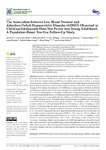The Association between Low Blood Pressure and Attention-Deficit Hyperactivity Disorder (ADHD) Observed in Children/Adolescents Does Not Persist into Young Adulthood. A Population-Based Ten-Year Follow-Up Study
Schulz, Jan
Huber, Franziska
Schlack, Robert
Hölling, Heike
Ravens-Sieberer, Ulrike
Meyer, Thomas
Poustka, Luise
Rothenberger, Aribert
Wang, Biyao
Becker, Andreas
Background: Attention-deficit hyperactivity disorder (ADHD) is one of the most common behavioral disorders in childhood and adolescence associated with relevant psychosocial impairments. The basic pathophysiology of ADHD may be related, at least partly, to a deficit in autonomic arousal processes, which not only influence core symptoms of the disorder, but may also lead to blood pressure (BP) deviations due to altered arousal regulation. Objectives: This study examined long-term changes in BP in children and adolescents with ADHD up to young adulthood. Methods: In children and adolescents aged between 7 and 17 years at baseline, we compared BP recordings in subjects with (n = 1219, 11.1%) and without (n = 9741, 88.9%) ADHD over a 10-year follow-up using data from the nationwide German Health Survey for Children and Adolescents (KiGGS). Propensity score matching was used to improve the comparability between children in the ADHD and control groups with now n = 1.190 in each group. Results: The results of these matched samples revealed that study participants with ADHD showed significantly lower systolic BP (107.6 ± 10.7 mmHg vs. 109.5 ± 10.9 mmHg, p < 0.001, Cohen’s d = 0.17) and diastolic BP (64.6 ± 7.5 mmHg vs. 65.8 ± 7.4 mmHg, p < 0.001, Cohen’s d = 0.16) at baseline. In a sensitivity analysis with a smaller (n = 272) and more stringently diagnosed ADHD group, the significant differences remained stable with somewhat higher Cohen’s d; i.e., 0.25 and 0.27, respectively. However, these differences did not persist after 10-year follow-up in a smaller matched longitudinal sub-group (ADHD n = 273; control n = 323), as subjects with and without ADHD had similar levels of systolic (123.4 ± 10.65 vs. 123.78 ± 11.1 mmHg, p = 0.675, Cohen’s d = 0.15) and diastolic BP (71.86 ± 6.84 vs. 71.85 ± 7.06 mmHg, p = 0.992, Cohen’s d = 0.16). Conclusions: At baseline, children and adolescents with ADHD had significantly lower BP (of small effect sizes) compared to the non-ADHD group, whereas this difference was no longer detectable at follow-up ten years later. These developmental alterations in BP from adolescence to early adulthood may reflect changes in the state of autonomic arousal, probably modulating the pathophysiology of ADHD.
Dateien zu dieser Publikation

